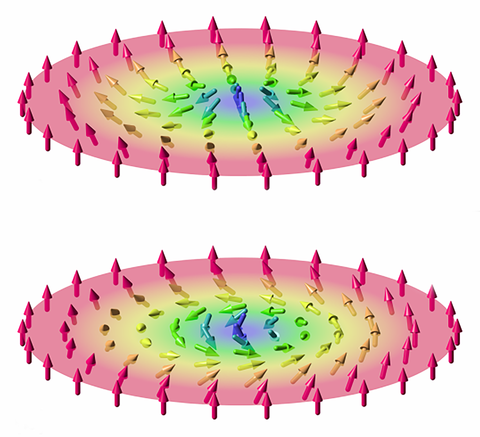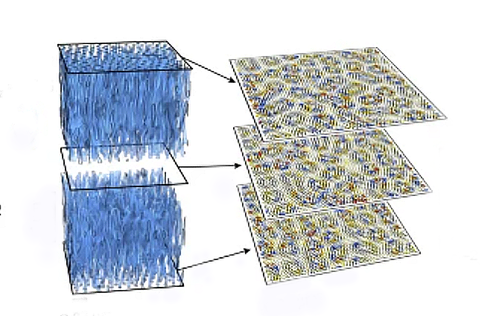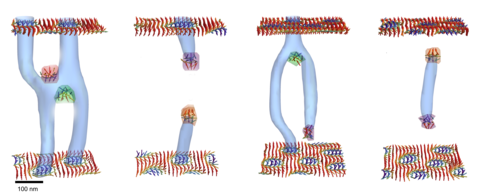Imaging the Elusive Skyrmion
Neutron tomography reveals their shapes and dynamics in bulk materials.

In thin strips, skyrmions are tiny, tornado-like 2D swirls in which the atoms’ magnetic orientations vary continuously and symmetrically.
Scientists at the National Institute of Standards and Technology (NIST) with colleagues elsewhere have employed neutron imaging and a reconstruction algorithm to reveal for the first time the 3D shapes and dynamics of very small tornado-like atomic magnetic arrangements in bulk materials.
These collective atomic arrangements, called skyrmions – if fully characterized and understood – could be used to process and store information in a densely packed form that uses several orders of magnitude less energy than is typical now.
The conventional, semiconductor-based method of processing information in binary form (on or off, 0 or 1) employs electrical charge states that must be constantly refreshed by current which encounters resistance as it passes through transistors and connectors. That’s the main reason that computers get hot.
But manipulating and storing information in stable magnetic states would require much less current (and heat) and allow much faster switching time between one state and another. This research field is called spintronics because it utilizes the spin – inherent magnetic polarity – of atomic particles and nanostructures instead of electric charge.
The NIST-led team is exploring one promising spintronic candidate: a vortex-like formation of atoms called a magnetic skyrmion. It arises naturally in certain kinds of atomic lattices in response to magnetic and electrical properties of the surrounding atoms. Skyrmions are typically in the range of 20 to 200 nanometers (billionths of a meter) in size. A human hair is about 100,000 nanometers wide.
In two dimensions, skyrmions take the shape of disks in which the atoms’ individual magnetic fields point in different directions (see figure) depending on their position on the disk – like the wind directions at different places in a tornado.

But in bulk materials, skyrmions can stack up vertically, forming 3D tubes, the tops of which can extend to the top and bottom surfaces of the material. If the shape of each tube was the same, then an array of skyrmions could be used to store data and could be switched from one state to another by applying a faint magnetic or electric field, much as information is read or written on a hard-drive platter.
“But the tubes do not form consistent shapes,” said NIST team leader Michael Huber. “They curve, twist, bifurcate, or terminate because of defects and asymmetries in the surrounding lattice. We’re trying to understand exactly what causes those effects, and how we can manipulate the material to control them.” The team reports its results in the August 14 issue of Nature Physics.
For the study, first author Melissa Henderson of the University of Waterloo made bulk samples – cubes about 3 mm on a side – containing 3D stacks or tubes of skyrmions in a lattice of cobalt, zinc, and manganese. They were brought to NIST for a novel form of neutron tomography, a process in which a beam of neutrons is directed at a sample. When the neutrons collide with different formations within the lattice – in this case, skyrmion tubes – they scatter off in different directions depending on the shape of the tubes at that point.
Each sample was placed in a magnetic field about the strength of a refrigerator magnet and rotated incrementally by very small angles, producing a series of “slices” that were then combined using a shape-reconstruction algorithm to make a single 3D image. (The process is analogous to a medical CT scan, which uses beams of x-rays instead of neutrons to form a 3D image.) The result showed how the shape and propagation of skyrmion tubes are linked to different kinds of imperfections in the surrounding lattice.

“In a perfect crystal, you'd have these perfect straight tubes that permeate surface to surface,” Henderson said. “But we know as scientists that there's no perfect crystal and so at any given temperature, you're going to have some crystal and magnetic defects that are going to interrupt these tubes.”
The researchers were able to determine how various sorts of localized defects in the lattice affected the shapes of the skyrmion tubes. “When we can get pure visualizations of these objects, and then we can change various parameters and understand how they respond,” Henderson said, “we can use them to tune future materials for spintronics.”
“It may sound somewhat exotic now,” Huber added. “But 10 years from now, you’ll go down to the electronics store and get a hard drive that is totally based on spintronic properties, with more densely packed storage and high efficiency.
“For that to happen, we have to understand features such as skyrmions, learn how to control them, and find the right materials.”
Paper: Henderson, M.E., Heacock, B., Bleuel, M. et al. Three-dimensional neutron far-field tomography of a bulk skyrmion lattice. Nat. Phys. (2023). https://doi.org/10.1038/s41567-023-02175-4

